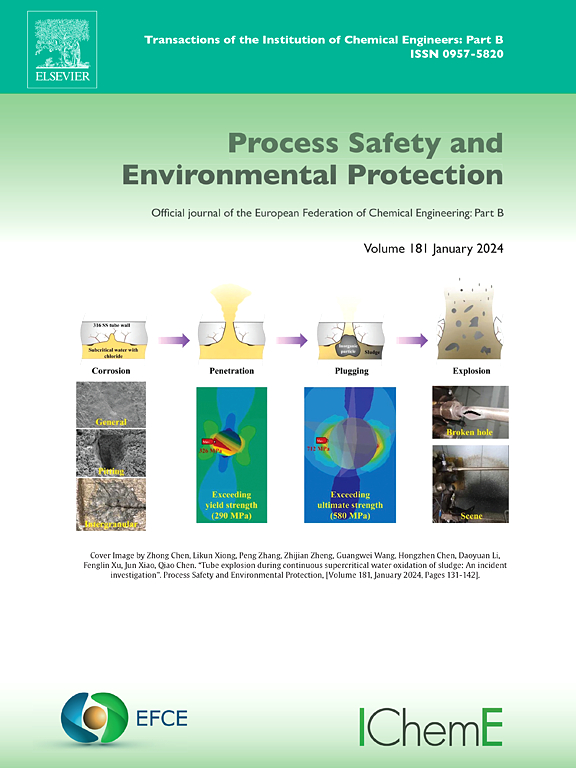通过热解揭示聚甲基丙烯酸甲酯化学回收的潜力:严格的建模,经济和环境评估
IF 6.9
2区 环境科学与生态学
Q1 ENGINEERING, CHEMICAL
引用次数: 0
摘要
热解被认为是一种很有前途的废塑料化学回收方法。虽然对聚甲基丙烯酸甲酯(PMMA)的热解进行了实验和可行性研究,但尚未建立全面的热解模型。为了弥补这一空白,本研究首先建立了一个全面严谨的PMMA热解过程模型。研究重点是热解反应器的一维三相夹带床模型,该模型彻底检查了质量,能量和动量平衡,以及热解动力学和热力学性质。随后,针对PMMA热解的不同场景,制定了合适的分离策略。对于工艺分析,技术经济评估(TEA)确定了回收甲基丙烯酸甲酯(MMA)单体的最低要求销售价格(MRSP),其范围为0.76至1.1美元/公斤,不同来源,单体产量不确定。然而,相应的价格还不到处女MMA成本的一半。此外,LCA表明,与焚烧和填埋处理相比,PMMA的化学回收在多个环境影响类别中具有实质性优势,包括全球变暖潜能值(GWP)、细颗粒物形成(FPMF)、陆地酸化(TA)、人类致癌毒性(HCT)、化石资源稀缺(FRS)和水消耗(WC)。研究结果进一步表明,含有杂质的PMMA源的热解,以及与单体收率相关的任何不确定性,可能会损害该过程的整体可持续性。总的来说,本研究为PMMA热解作为可持续回收方法的潜力提供了见解,有助于聚合物工业的经济效率和环境可持续性。本文章由计算机程序翻译,如有差异,请以英文原文为准。
Unraveling the potential of chemical recycling for poly(methyl methacrylate) through pyrolysis: Rigorous modeling, economic, and environmental evaluation
Pyrolysis is considered a promising method for the chemical recycling of waste plastics. While experimental and feasibility studies on the pyrolysis of poly(methyl methacrylate) (PMMA) have been conducted, a comprehensive pyrolyzer model has not yet been established. To address this gap, this study firstly develops a comprehensive and rigorous process model for the pyrolysis of PMMA. The research focuses on a one-dimensional, three-phase entrained bed model for the pyrolysis reactor, which thoroughly examines mass, energy, and momentum balances, as well as pyrolysis kinetics and thermodynamic properties. Subsequently, appropriate separation strategies have been developed for various scenarios of PMMA pyrolysis. For process analysis, a techno-economic evaluation (TEA) determines the minimum required selling price (MRSP) of recycled methyl methacrylate (MMA) monomer, which ranges from 0.76 to 1.1 USD/kg across various sources and with uncertainties in monomer yield. However, the corresponding price is less than half the cost of virgin MMA. Additionally, LCA indicated that chemical recycling of PMMA offers substantial advantages across multiple environmental impact categories compared to incineration and landfill treatments, including global warming potential (GWP), fine particulate matter formation (FPMF), terrestrial acidification (TA), human carcinogenic toxicity (HCT), fossil resource Scarcity (FRS), and water consumption (WC). The findings further indicate that the pyrolysis of PMMA sources containing impurities, as well as any uncertainties associated with monomer yield, may compromise the overall sustainability of the process. Overall, this study provides insights into the potential of PMMA pyrolysis as a sustainable recycling method, contributing to both economic efficiency and environmental sustainability in the polymer industry.
求助全文
通过发布文献求助,成功后即可免费获取论文全文。
去求助
来源期刊

Process Safety and Environmental Protection
环境科学-工程:化工
CiteScore
11.40
自引率
15.40%
发文量
929
审稿时长
8.0 months
期刊介绍:
The Process Safety and Environmental Protection (PSEP) journal is a leading international publication that focuses on the publication of high-quality, original research papers in the field of engineering, specifically those related to the safety of industrial processes and environmental protection. The journal encourages submissions that present new developments in safety and environmental aspects, particularly those that show how research findings can be applied in process engineering design and practice.
PSEP is particularly interested in research that brings fresh perspectives to established engineering principles, identifies unsolved problems, or suggests directions for future research. The journal also values contributions that push the boundaries of traditional engineering and welcomes multidisciplinary papers.
PSEP's articles are abstracted and indexed by a range of databases and services, which helps to ensure that the journal's research is accessible and recognized in the academic and professional communities. These databases include ANTE, Chemical Abstracts, Chemical Hazards in Industry, Current Contents, Elsevier Engineering Information database, Pascal Francis, Web of Science, Scopus, Engineering Information Database EnCompass LIT (Elsevier), and INSPEC. This wide coverage facilitates the dissemination of the journal's content to a global audience interested in process safety and environmental engineering.
 求助内容:
求助内容: 应助结果提醒方式:
应助结果提醒方式:


